When Sir Robert H. Davis, managing director and owner of the Siebe Gorman Ltd, in 1910 invented the famous DSEA (Davis Submerged Escape Apparatus), a kind of oxygen rebreather conceived for crew rescue in case of damaged submarines laying down the sea bottom and without any maneuver capability (see Fig. 1 and Fig. 2), certainly he could not imagine which developments this device would have had during the following decades, both in the military and in the sports branch.
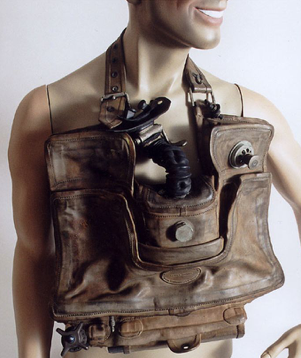 |
|
| Fig. 1 | Fig. 2 |
Through several experiments on this kind of rebreather, mainly carried out in the test pools of the Royal Navy and in those of the Siebe Gorman itself, this device was continuously improved and, starting with the end of the ’20 years, started to be used by several Navies including the Italian one.
Really, as frequently happens when successful inventions are considered, it is not clear if the DSEA was conceived by Sir Rober Davis in an independent way or if this apparatus has already been invented by Draeger from Lubeck in the same year (1910) through the model DM Tauchretter (see Fig. 3 and Fig. 4).
It was indeed the DSEA, purchased by the Italian Navy in 4000 units and manufactured under license by Pirelli (see Fig. 5 and Fig. 6 showing one of these units recovered from the wreck of the legendary Scirè submarine, sunk by the Royal Navy in front of Haifa on August 10th 1942), the rebreather model used as a base to develop the first experimental devices designed for the Italian Navy operators of the Human Torpedoes (also called Siluri a Lenta Corsa, SLC or more familiarly nicknamed “pigs”) (see Fig. 7 and Fig. 8).
| Fig. 3 | Fig. 4 |
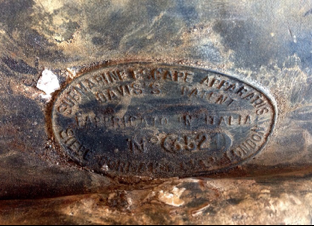 |
|
| Fig. 5 | Fig. 6 |
The first experiments with these rebreathers dated back to 1935 as part of the development work on these special torpedoes proposed to the Italian Navy by Teseo Tesei and Elios Toschi, the two naval engineering who had this intuition by taking inspiration from the lieutenants Paolucci and Rossetti exploits with the “mignatta” during the first world war (sunk of the Austrian battleship Viribus Unitis inside the Pola harbor in 1918).
The I.A.C. (Industria Articoli Caucciù) from Tivoli, a company purchased in 1938 by Pirelli, was requested by the Italian Navy Ministry to take care of the design and development of a rebreather suitable for this application.
| Fig. 7 | Fig. 8 |
To supervise this project was called the commander Angelo Belloni (see Fig. 9), a famous character related to the history of the Italian submarines development and well known for his almost completed deafness and for his numerous inventions on rescue and recovery of sunk submarines crews (see Fig. 10).
| Fig. 9 | Fig. 10 |
Still leaving the configuration of the new rebreather similar to that of the DSEA, but having to dramatically improve its operating range and its floatability, Belloni mainly worked on the following elements of the new device:
- Capacity of the soda lime scrubber
- Counterlung volume
- Capacity of the oxygen tanks
- Oxygen feeding system
- Replacement of the googles which were standard on the Davis rebreather by a full face mask embedding two separate glass
- Removal of the ascent speed reduction device (a kind of rolled curtain which was extended by the operator during the ascent phase to reduce the speed and to mitigate the risk of pulmonary air embolism)
The first model so developed (the “49”) during the water tests at Porto Santo Stefano reached an operating range of about 3 hours. The studies and the experiments on this rebreather continued also during the following years and led to the manufacturing of the model “49/bis” (see Fig. 11) before and of the model “50” later (see Fig. 12). The latter had a single glass full face mask and a radial type scrubber which would have remained the reference configuration for the next oxygen rebreather models, also developed after the second world war. These rebreathers have reached operating ranges in the order of 5 hours which were absolutely necessary, as demonstrated by the several war missions undertaken with these devices.
| Fig. 11 | Fig. 12 |
The dramatic improve in performances, unfortunately led to a significant increase in the mass and in the envelope of these devices, reaching a total weight of approximately 16 kg and a counterlung total volume of about 11 liters.
And in fact the commander Belloni who, after the Italy declaration of war on June 10th 1940, would have been appointed technical consultant of the new Italian Navy divers school in Livorno, was never capable to imagine such a rebreather like a device optimized for the underwater swimming. This application would have requested characteristics of hydrodynamics, compactness and lightweight well beyond the features of the SLC operators rebreathers.
Conversely, he remained very tight to the idea of an underwater operator transported by vehicles like the “pigs” or capable to approach the target to be destroyed by walking on the sea bottom. For this reason, the training sessions for the applicants of this specific branch of the Italian Navy included long and exhausting walks on the bottom with the typical equipment shown in Fig. 13 and in Fig. 14.
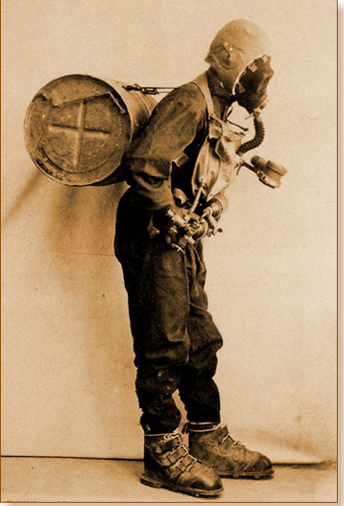 |
|
| Fig. 13 | Fig. 14 |
The velleity of Belloni about the presumed capabilities of the so called “underwater infantryman”, who would have transported on his back a 50 kg explosive barrel by walking for miles on shallow bottoms nearby the enemy harbors, then entering the harbor, finding the target, applying the explosive and finally coming back, were definitively dismounted by the “Gamma” frogmen team commander, the lieutenant Eugenio Wolk (Fig. 15), who was collaborating with Belloni himself.
Wolk, who was a swimming champion when younger and was still among the best swimmers of his team, could not walk for more than 3500 meters on the bottom before collapsing by fatigue and by CO2 breathing intoxication.
Most of his team members gave up well before, some of them already after some hundreds of meters. The fact is that the man has been created for walking on hearth and surrounded by air and not in the absolutely unfavorable conditions Wolk himself represented with some irony in the sketch of Fig. 16.
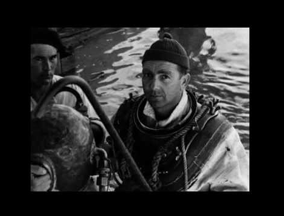 |
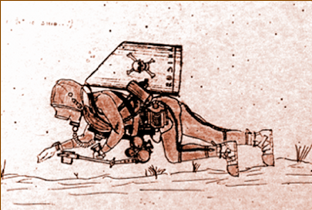 |
| Fig. 15 | Fig. 16 |
It was then necessary to review completely the equipment of the assault swimmer, better known as “Gamma” frogman, in such a way he would have become a military weapon really effective and feared by the enemy.
Above all the swimming capabilities would have been improved at the maximum both for the surface swimming phase, during the initial approach and the final return to/from the target (making most of mission duration), and for the underwater phase, when the explosives were applied to the target.
And therefore throw away the hard hat diver ballasted shoes, to be replaced by fins (the first short fins more or less of axial-symmetric shape and manufactured by Superga and by Pirelli), throw away the mask, which would have produced light reflections during the surface swimming phase, so leading to the operator’s detection by the enemy. Moreover, the mask would have been almost useless for the underwater vision since the attack phase occurred in the complete darkness and the operators were trained to locate the points where to secure the explosives on the target only through touch recognizing of the different sections of the ship.
The operator was equipped with a nose clip (see Fig. 17), to be used during the attack dive, and a sort of camouflage of his head which was covered by a net full of sprigs and leaves so appearing like small floating objects and debris. The heavy and cumbersome “Belloni” suit, used by the human torpedoes operators, was replaced by a complete dry suit, made by thin rubber sheets. This suit demonstrated to be pretty fragile and poorly protective in cold waters. The explosive bag application phase by the Gamma operator, is well shown in commander Wolk sketch of Fig. 18.
Upon request of the Gamma team, Pirelli developed an oxygen rebreather model explicitly designed for this new specialty (see Fig. 19), with an operating range limited to 40 minutes only, but with space envelope, weight and volume features well below those of the long range rebreather models. As shown in Fig. 20, this rebreather is worn by the MOVM (Military Value Golden Medal) Prof. Luigi Ferraro, universally recognized together Duilio Marcante, as the father of the Italian diving educational programs, as well as the founder of Technisub.
Ferraro undoubtedly was the most famous Italian Gamma frogman thanks to his extraordinary exploits of Alessandretta and Mersina in Turkey during the last world war, when he alone sank or heavily damaged 4 merchant ships carrying goods and materials for the United Kingdom.
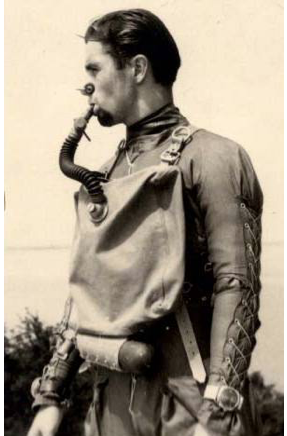 |
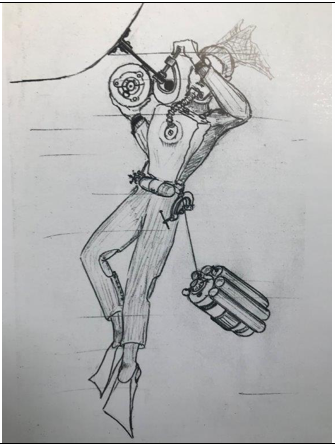 |
| Fig. 17 | Fig. 18 |
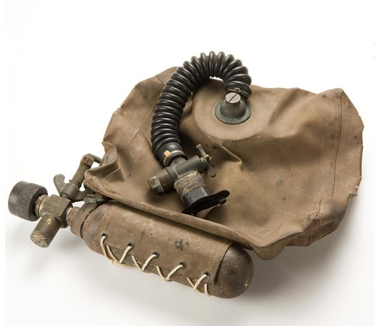 |
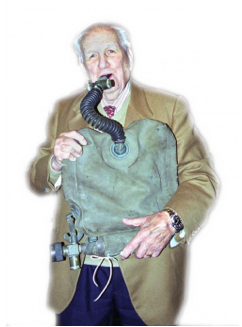 |
| Fig. 19 | Fig. 20 |
The Italians, in addition of being the forerunners in these military specialties, became also the reference points for the other foreign navies who decided to equip themselves with the same underwater assault teams. The German themselves, who certainly from the military standpoint had very few to learn from other countries, recognized the Italian Gamma organization as a team of absolute excellence worldwide and asked to educate their military personnel at the Italian assault motorboats and at the Gamma frogmen training schools.
After the second world war, sports diving started to diffuse along the Italian coasts as well, mainly as “spearfishing”, a discipline developed more for food needs, considering the hunger conditions left by the war among the population, than for pure sports passion. People was diving with self-made gear, realized by cutting and shaping old car tire inner tubes and then gluing the rubber parts so obtained with glass or transparent plastic sheets in order to get rudimental masks. There was somebody who, considering the good availability of military oxygen rebreathers, which could be purchased at low prices in the military warehouses of surplus materials, also with no knowledge of their correct utilization techniques, did not hesitate to use them during their spearfishing dives, more to extend of some minutes their underwater range than as a real SCUBA unit.
From 1946 the modern SCUBA unit, realized by the Cousteau-Gagnan regulator, started to diffuse in the market, in France before and in the rest of the world later, but almost ten years would have passed before this SCUBA unit was really available in Italy, still with prices not accessible to most of the divers in that period.
Some of the few Italian companies which were remained active in the production of diving gear for military and sports applications (Pirelli, Cressi) foresaw the commercial opportunities the market could offer, by proposing an underwater breathing device specifically designed for sports and spearfishing applications and with a price accessible to most of the divers of those years. Off course, the design and the manufactureing of the right devices were not sufficient: it would have been necessary to teach the future customers their correct and safe utilization techniques, to dramatically reduce the great number of accidents, mostly fatal, happening among the many users of the military oxygen rebreathers. These divers, completely ignorant about their utilization rules and the potential risks related to a wrong use of these rebreathers, often went underwater well beyond their operating limits, so facing accidents which mostly led to the worst scenarios.
Cressi was engaged on both these two aspects and, for this reason, hired the above mentioned Prof. Luigi Ferraro as Technical Director. Who better than Ferraro intimately knew the oxygen rebreather and then could suggest to the company how to develop a model for sports and spearfishing applications to be used by amateur divers? This project from Cressi was realized through the model “47” (see Fig. 21), so called because it was put in production starting from 1947. In the picture of Fig. 22 you can see the same device used by Egidio Cressi during one of his summer dives at the Aeolian Islands.
Let’s now analyze in details the main elements of this rebreather which were defined to optimize its use as sports and spearfishing device.
- Counterlung dimensions. These dimensions were significantly reduced with respect to those of the military rebreathers, except those for the Gamma frogmen, which have been already modified during the war period. Cressi initially proposed two counterlungs having slightly different volumes for two rebreather models of different operating range: the “light” model, with a declared operating range of 1,3 hours, and the “heavy” model, with an operating range of about 3 hours. The typical volumes of these counterlungs settled to a value between 5 and 6 liters.
- Number and dimensions of the oxygen tanks. Whereas for the military rebreathers the standard was of 2 tanks of at least 2 liters, for the “47” and for all the equivalent models manufactured in those years, the tank became only one with volumes variable between 0,8/1 liters for the “light” models and 2 liters for the “heavy” models.
-
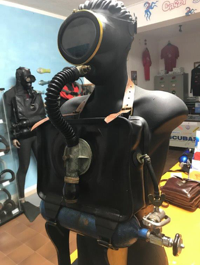
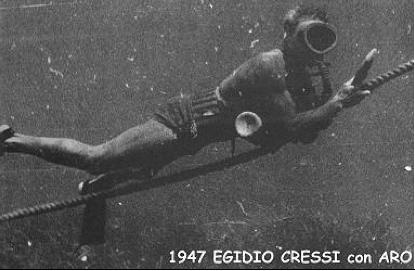
Fig. 21 Fig. 22 -
Relocation of the oxygen tank valve/by-pass manifold from the right side to the left side. The reason of this upgrade consists in the fact that, being these rebreathers mainly dedicated to the spearfishing and being the “right-handed” divers in greater number than the “left-handed” ones, the diver could easily operate the oxygen by-pass by his left hand while grasping the spear gun by his right hand.
-
Simplification of the oxygen feeding/by-pass valve. In the military models dedicated to the human torpedoes operators, this valve included an oxygen steady flow feeding circuit , with flow rate adjustable by the operator, and a manual by-pass valve which could provide oxygen to the counterlung for any needs (see Fig. 23). In these new sports rebreathers, considering their simplification and their cost down targets, only the by-pass device was maintained (see Fig. 24).
- In the Cressi oxygen rebreathers was then introduced a patented device which would have been the recognition element for the whole range of oxygen rebreathers made by the Genoese company in the following years: the “small barrel” for the breathing gas condensation and salivation gathering. This device was surely suggested by Ferraro well aware of the issues related to the soda lime scrubber working efficiency when an excessive quantity of water was present.
- Full face mask. Looking at the 1947 Cressi catalogue, you can see the offered oxygen rebreather were not provided with any full face mask. This situation could be found also for some models offered by the competition in those years (i.e. Polifemo Pirelli). However, in the following years the full face mask became a standard provision of this rebreather (see the Cressi catalogues related to the following years). This apparent strangeness can be justified again through the contribution of Ferraro who, having to organize diving educational methods and materials for the training phase concerning the utilization of these devices, had to consider the additional safety factors offered by a full face mask. This component has proven to be very useful is saving life when the most dangerous accidents, caused by a wrong use of these rebreathers, occurred underwater (blackout due to anoxia or convulsions due to hyperoxia). For this reason the utilization of the full face mask would have been remained mandatory during the open water sessions of the FIPS educational programs until nowadays.
| Fig. 23 | Fig. 24 |
During the period extending from the armistice, on September 8th 1943, to the end of the war, the Gamma training center was moved from Livorno to Venice, on Saint Andrew Island. Here the development work on the materials for the SLC operators and for the Gamma frogmen continued with the support of Pirelli e with the supervision of commander Belloni. Precisely the activities on Saint Andrew Island continued also after the end of the war for almost 2 years, until the whole Venice harbor area and the upper Adriatic coasts were cleared from minefields and from the numerous wrecks sunk by the Germans before their withdrawal.
Among the several experimented models, there was also the so called “sports model”, as identified by Belloni, which was developed directly from the model designed for the Gamma frogmen.
This model was improved for the sports and spearfishing applications by the addition of a full face mask (the same used on the G50 model) and of an integrated snorkel provided with an automatic sealing valve when underwater (see Fig. 25 and Fig. 26).
This model, called “Poseidon”, started its production phase in 1947 e was followed, starting from 1952, by its bigger brother “Polifemo” having the same counterlung of the professional model “L.S. 901” and sold without any full face mask (see Fig. 27 and Fig. 28).
The typical shape of the Poseidon counterlung but also its typical performances, completely identical to thoseshown in the 1947 Cressi catalogue, allow us supposing that Cressi used some important parts of this rebreather to complete its “light” model, as shown in the catalogue. This model would have disappeared during the following years and the “47” would have been proposed only in its “heavy” version. This hypothesis is supported by the fact that Cressi, immediately after the end of the war, included in their catalogue some rebreathers manufactured by Pirelli (i.e. the C.F. 49 and the C.F. 69), acting in fact as a distributor of this latter company.
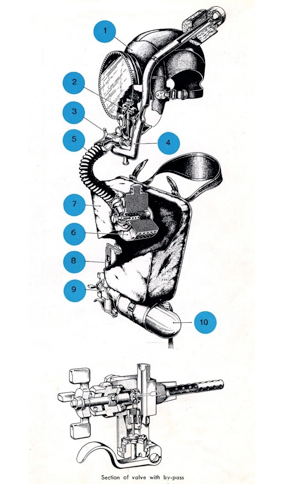 |
|
| Fig. 25 | Fig. 26 |
The only significant experience outside the national borders about the utilization of this type of rebreather for reasons different than the military ones, was carried out by the Austrian Hans Hass, a famous underwater zoologist and documentary maker. This scientist, starting from the expedition in Greece through the Aegean Sea in 1942, used a Draeger oxygen rebreather, the “Tauchretter” model (see Fig. 29, Fig. 30 and Fig. 31), which would have become his inseparable diving buddy also in the following expeditions. This rebreather, still having similar performances of the Italian sports models produced immediately after the end of the war, included two main distinguishing elements. The first of those was the cyclic breathing loop type versus the pendular one (a typical characteristic of many models manufactured by the company from Lubeck) and the second was the counterlung located in the diver back side, immediately behind his head (see the famous picture in Fig. 32 showing Lotte Hass during a dive with this rebreather). Lotte was the wife/model/secretary of the famous Austrian scientist.
However, despite the experiences developed by Hass and by his team and the outstanding media and advertising campaign realized through his movies and his books, nobody in Austria and in Germany thought of proposing this device to the market and of developing the related educational programs. Therefore, this remained an experience limited to the scientific and didactic world only with no commercial consequences concerning the gear used during Hass several expeditions.
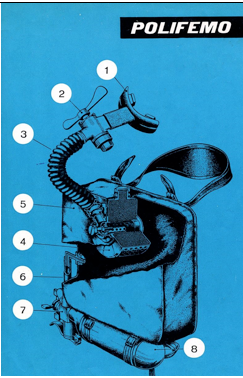 |
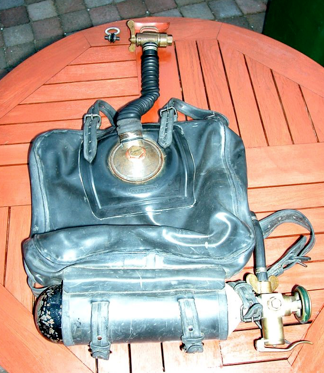 |
| Fig. 27 | Fig. 28 |
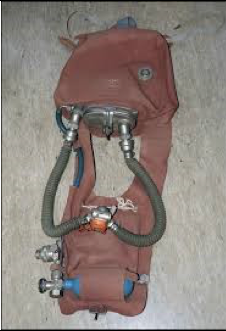 |
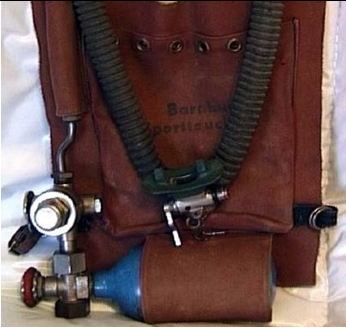 |
| Fig. 29 | Fig. 30 |
What happened in the meantime in Italy for the new sports divers (who were supposed to be the users of the new oxygen rebreathers) educational program side?
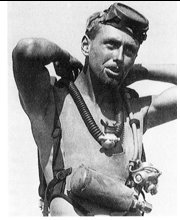 |
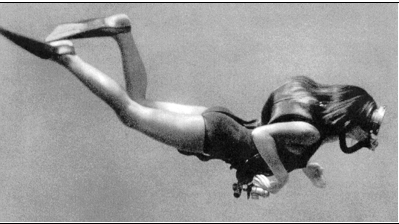 |
| Fig. 31 | Fig. 32 |
Once again Luigi Ferraro, supported by the inseparable Duilio Marcante, would have been a pioneer also on this matter. Everything started in the summer of 1948 at the camping village of the Italian Touring Club in Marina di Campo, Elba Island. As you can see in the pictures of Fig. 33 and Fig. 34, Ferraro used the oxygen rebreather Cressi model “47” for the training of these first sports divers. These rebreathers were made available, for advertising and sales campaign reasons, by the Ferraro’s employer Egidio Cressi.
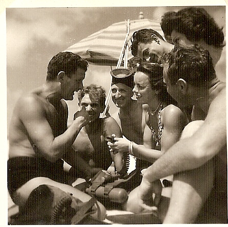 |
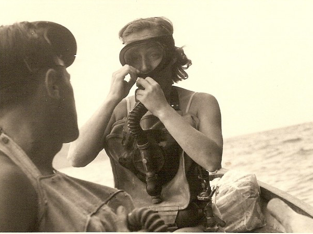 |
| Fig. 33 | Fig. 34 |
This experience was repeated the following year at the Ischia Island and in 1950 at the Aeolian Islands on board of a motorsailer boat, so inaugurating what would have become the diving tourism. Off course Ferraro well knew that, working alone, the number of divers he could have taught on the correct use of this rebreather would have been very limited and not sufficient to generate a market of consumers capable to justify the production, at the industrial level, of these devices. Therefore, it would have been necessary to widen the user base of these training courses, through an educational organization well diffused and active on the whole Italian territory. Before the Ferraro’s final target would have been reached in 1957 with the entrance inside FIPS, the CONI federal organization responsible for the sports fishing activities, the new educational materials and programs continued to be developed and optimized through new fundamental experiences. These efforts were dedicated to the creation and the training of the first diving teams of the main Italian military and professional government organizations.
The first training course was organized in 1952 and allowed to create the first Italian Fire Fighters Brigades Diving Team (see Fig. 35 and Fig. 36). During the following years also the other government organizations joined these courses and precisely the Carabinieri, the Police and the Finance Guard . All of them organized their fully autonomous diving teams. In these first professional training courses, the basic underwater breathing device remained the oxygen rebreather, a system also adopted by the same government diving teams to carry out many of their operating missions when the depth limits allowed its use (see Fig. 37 and Fig. 38). Although the reference users for these new rebreathers remained mainly the spearfishing divers, we report here the oxygen rebreather, particularly in its sports version, was effectively used also in the underwater photography and video recording applications, under great development in those years. As an example the pictures of Fig. 39 and of Fig. 40, showing two famous underwater photography and video pioneers, Lino Pellegrini and Victor De Sanctis, both of them using the oxygen rebreather, are included below.
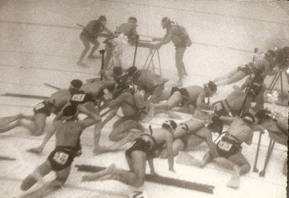 |
|
| Fig. 35 | Fig. 36 |
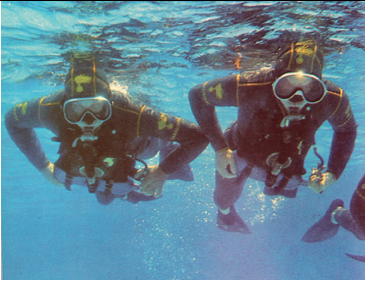 |
|
| Fig. 37 | Fig. 38 |
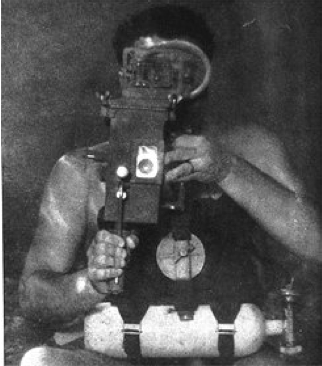 |
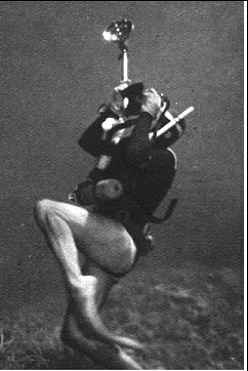 |
| Fig. 39 | Fig.40 |
Let’s analyze a bit more closely the manufacturing techniques used during the production of these devices designed for underwater sports applications.
These techniques were remained mainly of handcraft type with most of the manufacturing operations still performed manually. Let’s take as an example the counterlungs which were built by cutting and shaping rubberized fabrics. The parts so obtained were assembled together by sewing or bonding processes and finally vulcanized (see the counterlung of the Cressi model “47” in Fig. 41 and the counterlung of the Pirelli “Poseidon” in Fig. 42).
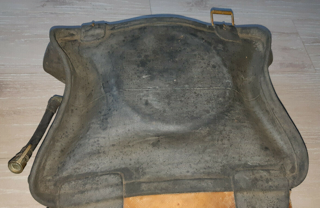 |
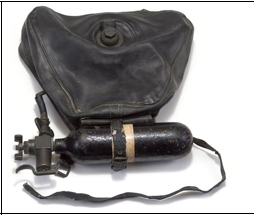 |
| Fig.41 | Fig.42 |
The only element of the counterlung made in natural rubber was often bonded and vulcanized on the front side of the lung to allow the introduction and the removal of the scrubber, thanks to the outstanding elasticity performances of this material (see Fig. 43 and Fig. 44).
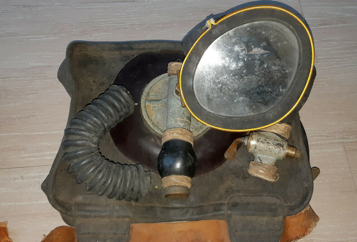 |
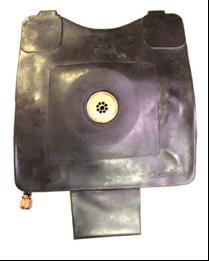 |
| Fig.43 | Fig.44 |
The metal parts of these rebreathers also requested long manual manufacturing processes, sometime needing high skilled operators. As an example, two main components of the Cressi oxygen rebreather are shown, the soda lime scrubber (see Fig. 45) and the oxygen by-pass (see Fig. 46).
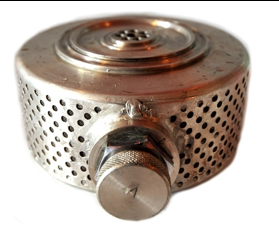 |
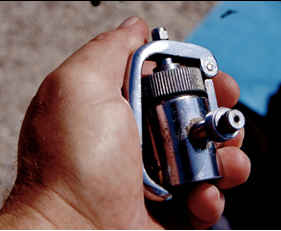 |
| Fig.45 | Fig.46 |
Both of these components were assembled through mechanical machining of marine brass sheets and bars. Then the machined parts were assembled together by braze welding and finally submitted to chemical nickel plating treatment. In the case of the two-way shut-off valve (the component linked to the oxygen corrugated hose and to the mouthpiece), in order to prevent any oxygen leaking, the two main parts of the valve had to be coupled through a manual polishing process using abrasive paste.
The whole process was not exactly compatible with a mass production of these devices, from both the manufacturing costs and the available skilled workers standpoint. This probably was one of the reasons leading to the decision of Cressi who definitively stopped the production of these rebreathers at the end of the ’70 years.
For these reasons, when the request from the market of sports oxygen rebreathers significantly grew, mainly thanks to the creation of diving schools as part of FIPS organization, Cressi decided to replace the “47” model with the “57B” model (see Fig. 47). This new rebreather would have become the “battle horse” of the FIPS diving schools from 1957 to the end of the ’80 years, well beyond the production stop of this rebreather at the end of the ’70 years.
All the rebreather metal parts (scrubber, by-pass, tank valve, two-ways shut-off valve, counterlung connecting front plate) remained unchanged, but the main news was the counterlung manufacturing process. This important component was built by injection molding of two natural rubber elements which were then assembled together and finally vulcanized (see Fig. 48). In the redesign of the new counterlung, Cressi choosed a sort of “horseshoe” shape with the addition of two appendices located on the upper part of the lung and symmetrically with respect to the scrubber soda lime inlet cap. These appendices allowed to slightly increase the lung total volume (from 6 liters of the “47” model to 6,5 liters of the “57B” model) and, at the same time, to elevate a bit the center of the lung with a slight breathing effort reduction.
The neck strap and the ventral belt of the new rebreather, made by leather in the previous version, were manufactured in nylon fabric.
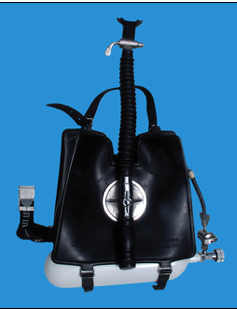 |
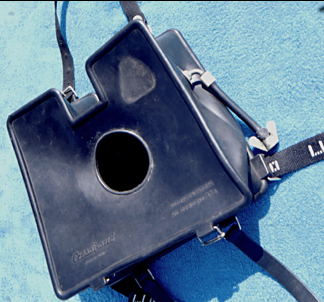 |
| Fig.47 | Fig.48 |
These modifications allowed Cressi to significantly reduce the manufacturing cost of this rebreather.
At this point the reader could easily ask the following question: how is it possible that, despite the introduction of the SCUBA unit in the Italian market starting from the middle of the ’50 years, the use of this oxygen rebreather in the FIPS educational programs remained so diffused and popular until the end of the ’80 years?
Let the same Duilio Marcante reply to this question. Marcante, who was the father, together Luigi Ferraro, of the sports diving educational programs in Italy, in the very famous handbook “Manuale Federale d’Immersione (Federal Diving Manual)” a fundamental work for the FIPS diving schools along some decades, clearly says: “In the educational programs approved by our federation the oxygen rebreather is considered first of all as a training device. In fact most part of the training is carried out by this not automatic rebreather, requesting a continuous control of the hydrostatic situation, allowing to devise a great number of highly formative exercises, imposing very correct and calibrated movements and finally needing a breathing rhythm voluntarily altered and continuously controlled. The fact that only the training third level only allows its use is a proof that this rebreather is considered to be reserved to the experts only.” In the Marcante words one can easily guess why all the oxygen rebreathers designed for the sports diving training in Italy remained of the pendular type, just because the altered breathing, necessary with this devices, was considered among the formative elements offered by this system.
Thanks to this formulation, absolutely original for the Italian diving educational organizations in those years, many FIPS diving schools acquired a great number of “57B”, rebreathers, also thanks to their limited price (see Fig. 49 and Fig. 50).
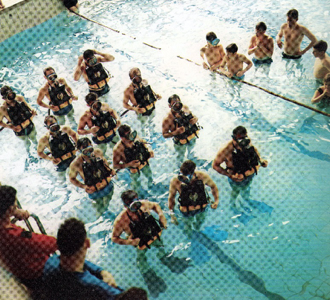 |
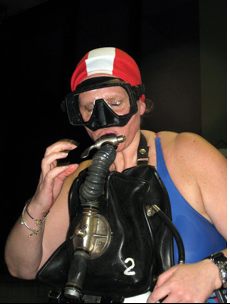 |
| Fig.49 | Fig.50 |
The oxygen rebreather for Marcante remained always an object to love but also to hate. To love, because it allowed him to develop a diving educational methodology highly formative and selective, but also to hate, considering the numerous fatal accidents happened with this rebreather he had to witness during his life. Some of these accidents involved also brotherly friends (i.e. the death of Dario Gonzatti in San Fruttuoso di Camogli bay in 1947, an experience leading him to conceive the idea of the Cristo degli Abissi (Abyss Christ), idea which he was able to realize in 1954).
When Luigi Ferraro left Cressi to found in 1962 his own company, the Technisub, one could expect he would have put in the market an oxygen rebreather capable to get some market share from the Cressi 57B model. This really happened but not completely because this new rebreather, which was designed with very innovative characteristics and very high level performances, was never considered a device for the sports diving training but instead a professional rebreather competing with the similar models available on the market and manufactured by Italian and foreign companies (i.e. Pirelli, Salvas, OMG, Draeger, etc.). This model, simply called “Nuovo ARO” (see the standard version with one steel tank in Fig. 49 and the military no magnetic version with two aluminum tanks in Fig. 50), was put on the market in 1973. Unfortunately this model never reached good sales numbers mainly due to its price which was significantly higher than those of the equivalent models available in the market.
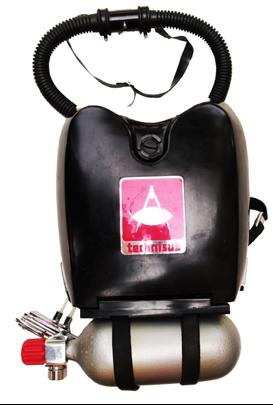 |
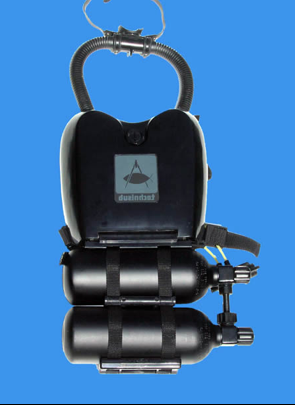 |
| Fig.51 | Fig.52 |
As already anticipated before, at the end of the ’70 years Cressi decided to definitively interrupt the production of their “57B” oxygen rebreathers. Therefore, the problem of the replacement of this rebreather, still a fundamental training element of the FIPS diving schools organization, emerged clearly. At that time the so called “commercial” diving educational agencies were still not penetrated in Italy, but the monopoly period of FIPS in the Italian diving schools scenario, was coming to an end.
Walter Bosio, a former Italian Navy seal, accepted the challenge of replacing the Cressi 57B oxygen rebreather and proposing a new device specifically designed for the sports diving training but with good characteristics in terms of state-of-the-art, costs and manufacturability. The results of his job led to the project of the “Naubos AR88” oxygen rebreather, a model available in two configurations and manufactured by Nautilus from Milan. The basic version had one tank located in the bottom of the device (ventral position) (see Fig. 51) and the “transformable” version, had two tanks and related valves and by-pass devices, located on the two sides of the counterlung (see Fig. 52).
Let’s now look in details at the main design elements of this rebreather and at the reasons leading to the selection of its specific solutions.
- The element, submitted to the greatest modifications with respect to the “57B”, was undoubtedly the counterlung. The counterlung of the Cressi rebreather, though very easy from the manufacturing standpoint, was pretty fragile and susceptible of continuous failures especially because of the poor strength of the connection points among the lung, the neck strap and the tank. To prevent these failures one thing taught at the beginning of the training course was to handle the rebreather by its tank valve when operating it out of the water. The other cause of the lung failure was the rubber aging which, especially when submitted to the UV rays, hardened so producing cracks and cuts in the most loaded areas.
Starting from similar solutions used on some military rebreathers, the designer decided to develop a two-elements casing: an external bag made by sturdy coated fabric and having the function of sustaining the total weight and all the operating loads and an internal one, made in polyurethane latex and having the function to contain and to seal the working gas volume. The internal bag could easily introduced inside the external bag through openings closed by zippers and velcro straps.
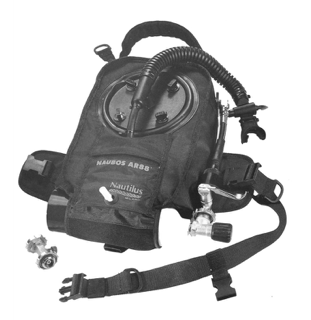 |
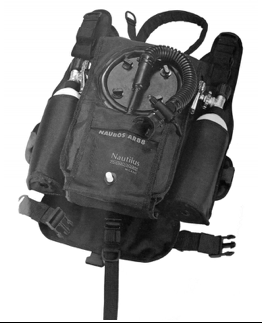 |
| Fig.53 | Fig.54 |
- Most of the metal components of the “57B” model (scrubber, front plate, two-ways shut-off valve) was replaced by equivalent components made by glass fibers reinforced nylon. This material was more suitable to be molded in great quantities and at limited costs.
- Analyzing the typical training dive using these rebreathers in the swimming pool or in the open waters, it could be realized that the operating range allowed by the soda lime quantity in the scrubber and by the 2 liters oxygen tank of the 57B model, was significantly larger of the real needs. Consequently, it was necessary, between two training sessions, to scrap a quantity of soda lime still efficient or to refill oxygen tanks still partially charged. Therefore, to make the use of this new rebreather highly convenient for the diving schools training activities, the scrubber soda lime quantity was reduced from 1 kg to 700 grams and the volume of the oxygen tank from 2 liters to 0,8/1 liters, according to the selected tank material (steel or aluminum).
- The by-pass material remained the marine brass but its body was stamped rather than machined and then chromium plated. The oxygen sealing capability was improved by adding O-rings on the critical couplings.
- The whole harness of the rebreather was redesigned and improved for better swimming efficiency and better comfort of the diver when underwater.
A very compact and light rebreather came out (the basic version with a single tank weighed 3,5 kg only versus 7,8 kg of the “57B”). After the production start in 1988, FIPS modified the training materials related to the rebreather teaching program, which would have become a simple specialty course, by replacing the references to the “57B” model with those related to this new device.
In 1990 Nautilus also proposed a professional version of this rebreather, the Naubos AR90, with a bigger counterlung (from 5,2 liters to 6,5 liters) and a 2 liters tank, unfortunately with no significant sales success.
In those years there was another known Italian diving gear manufacturer, Demetrio Morabito, the owner of the Mordem company, who launched himself his own oxygen rebreather (see Fig. 53), a very innovative device for sure but which unfortunately had never commercial success and was never considered as a replacement of the Cressi “57B” model for the FIPS diving schools.
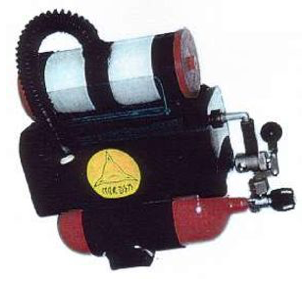 |
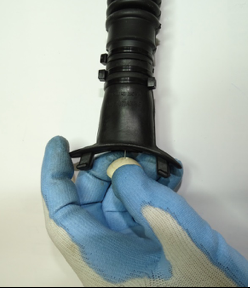 |
| Fig.55 | Fig.56 |
One of the reason of this incompatibility with the FIPS diving educational programs consisted in the specific “self-sealing” mouthpiece (see Fig. 54) of this rebreather (a small plastic ball pulled by a lanyard, energized by a spring, which automatically sealed the mouthpiece inlet when the diver lost contact with that). The use of this special mouthpiece would have made necessary the modifications of some basic rebreather operating techniques, techniques well consolidated along many years of experience in the use of these rebreathers (removal and taking contact with the two-ways shut-off valve and mouthpiece). This model, after an initial manufacturing batch of few decades of units, was definitively put out of production at the end of the ’90 years.
Another aspect analyzed in this article is how the cost of these sports oxygen rebreathers could have influenced their diffusion on the market from the end of the second world war to the end of the ’90 years when, basically, all the models described before have been already phased out of production. After having found their sales prices (expressed in Italian Lira) from old catalogues and price lists, these data have been analyzed by a specific calculation tool, available on the web, which is capable to calculate the current value in Euro starting from the price in Lira and from the year at which the price is referred. The results of this analysis are shown in the following table.

Looking at the table above, one can get the following conclusions:
- The price of the Cressi “57B” model has been the lowest among all and never approached by the other models introduced in the market during the following years.
- This price, especially during the first years of production of this rebreather, was less than a half of that of a SCUBA unit and therefore much more convenient to be purchased by the FIPS diving schools, even in great numbers.
- The rebreathers manufactured after the phase out of the “57B” model, costed more than twice of the Cressi device, despite the design efforts carried out to make them the cheapest possible.
- The Technisub rebreather had a price not compatible with those suitable for the diving training schools.
For the oxygen rebreathers produced more recently, the price remained higher than the initial target mainly because the sales number were significantly lower than those expected. This prevented a reasonable absorption of the manufacturing costs for the numerous production tools requested by the new design solutions (mainly injection molding tooling for the plastic components) and therefore the need to charge a great part of these costs on the rebreather sale prices.
In the period of the strongest commercial efforts to launch these rebreathers on the market (from the beginning of the ’80 years to the beginning of the ’90 years) in Italy the overseas diving training agencies had arrived in force (PADI, SSI, NAUI, etc.). These agencies completely upset the diving schools world in Italy at the sports and recreational level. Getting a diving license was becoming much simpler and less selective than in the past, the new diving educational programs did not forced anymore the students long training periods with difficult and often tedious exercises and with diving gear difficult to manage and which would not have been used during the real dives in open waters.
The oxygen rebreather was suddenly become a gear completely far from the new diving training targets and from the commercial context these new agencies were operating in.
FIPS himself, who had somehow adapting to this new situation through substantial modifications of his training programs, although not retiring completely this rebreather, confined it as a special equipment to be used as part of a specialty training course.
The tombstone for these Italian pendular type rebreathers, supposing that these had some sale perspectives also in the professional applications and abroad, was the publication in 2003 of the European regulation EN 14143, precisely dedicated to the underwater closed loop breathing apparatus. This regulation requested specific limits for the carbon dioxide concentration to not be exceeded inside their breathing loops, independently from the breathing technique taught in the Italian diving schools. These limits were impossible to be met by the pendular type rebreathers and this fact led to their end as products to put in circulation with the “CE” marking.
An Italian historical diving era was then over, an era started with the outstanding military exploits of the human torpedoes operators and of the Gamma frogmen during the second world war and concluded with the invasion of the so called commercial diving agencies. This latter period was formally started in 1979 with the first PADI instructors course organized in Italy by Guido Picchetti and then fully realized during the ’90 years.
From that moment on the pendular oxygen rebreathers would have been transformed from unparalleled gear for the training of new sports divers to simple objects for diving gear collectors and diving history lovers.
Luckily, thanks to the several enthusiasts and lovers operating on the national territory, many of these rebreathers are still restored and brought to a level of full operating efficiency. Some of these devices are used during specific training courses dedicated to the oxygen rebreathers, others are used during real dives in rivers, lakes or at the sea to rediscover the real charm of diving, in the absolute silence only this type of rebreather is capable to give.
______________